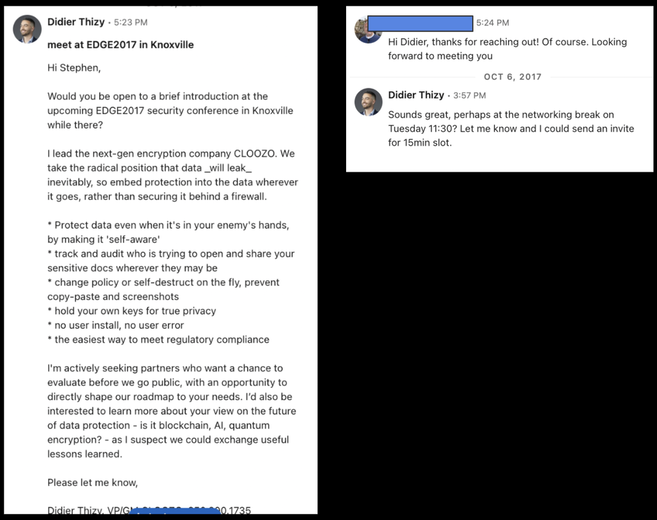|
CIOs (Chief Information Officers) are smart, busy, and flooded with meetings. Internally, their peers and teams are constantly notifying them of status and new fires. Externally, they are flooded by sales calls. It's exhausting.
So how do you get an audience with them? And when you do, how do you get their attention and respect? In short: how to talk to a CIO? IF YOU ARE IN SALES AND MARKETING: HOW TO GET IN FRONT OF A CIOTalk to Mid-level Staff First CIOs and other C-levels are bombarded with promotions. Most of the time, you want to talk to mid-level managers first and let them eventually tell their CIO about you. This may feel very indirect, but ultimately is better because:
C-level Roundtables and Other Intimate Settings
Because the market is so noisy and channels are saturated, the more intimate approach where you are actually meeting customers face-to-face and making a human connection can produce more real opportunities than blasting a message to thousands of prospects online. At a company I worked for, this is how we got the bulk of our enterprise opportunities. In the IT security space for example, check out CISO Executive Network as an example where each local chapter hosts 3 speakers and 20 CISOs a month. Go speak at this conference, be credible and memorable, and then network the room. Referrals and Partner Marketing CIOs and CISOs rely on trusted partners such as consultants, managed service providers (MSPs) and trusted vendors who are already established in their ecosystem. Getting a referral from one of these trusted sources can be more effective than trying to make a cold introduction. Find the top 100 MSPs in your market and meet them directly. Sometimes even being friendly with potential competitors makes sense here, whoever can refer you to the CIO rather than you trying to make a cold introduction. Companies in the IT security market have got this down to a science: everyone is both a partner when it comes to finding referrals (a necessity in such a noisy industry) but also competitors on other deals. For busy CIOs, you are way more likely to take a meeting from a trusted referral than a cold intro. Reach Out to CIOs When They Are Speaking At a Conference When executives go to speak at conferences, they intend to network. They may be open to an invitation to briefly meet. Here's an example of a direct invitation I sent on LinkedIn to the CIO of a large enterprise who happened to be speaking at a conference I was going to attend. He replied, we met for about 5 minutes after his talk, and agreed to have a phone call a week later. It eventually turned into a major opportunity for the business I was leading!
Often I will send messages like the above even before booking my travel to the conference, as a way of validating that it would be worth it to go. If enough speakers or exhibitors agree to meet, then it would be worth it.
Of course, many speakers won't reply, and I just take it to mean that they're too busy or not interested. Sometimes the speaker I reach out to responds saying that they're too busy to meet during the conference, but could meet via phone instead when they get back to their office. That works too! IF THE CIO AGREES TO MEET, HOW DO YOU TALK TO THEM?Help them understand what category you are in. The market is so noisy that explaining upfront what market category you fit into is key. Are you Data Loss Prevention? Backup? ERP? Custom App Development? Is there a Gartner Magic Quadrant you can point to, or other point of comparison. A lot of companies don't want to label themselves but clarifying a general category right away will really help the CIO follow. If you are too unique then you risk just being noise. Help them understand what's different about you. Assuming you got the first part right (what category), now you want to explain how you are different. Get to the point quickly. Are you faster, cheaper, or better than others in your category? Or maybe it's some other differentiator. Whatever it is, frame it in terms of benefits the CIO will understand and appreciate. Be honest. Do your homework about their company and industry, challenge their point of view, but don't presume to know too much. At the end of the day you are an expert in your world, they are an expert in theirs, crossing that boundary too quickly is disingenuous. Talk like a regular person. There is so much junk science out there for sales people about how to talk to prospects. Anything that you say or do in your work life, ask yourself: "Is this what a normal person sounds like?" If not, knock it off and just be a human being. Make a reasonable ask. Chances are you are not going to pitch a million-dollar deal on the first meeting. But make a more reasonable ask. "I'd like to set up time to show you a demo." or "I'd like to understand who in the organization we could work with on a prototype." It could also simply be "could we meet again to talk further?" HOW TO REPORT STATUS TO A CIO (GOOD OR BAD)
If you're on the inside, a PM or Director responsible for delivering a significant program for example, and you need to provide status to the CIO, congratulations! You're in the spotlight :)
Consult with your manager and others on what the CIO wants to know most. Resist the urge to provide a lengthy update with lots of details. Typically the CIO (and other senior leaders) will have only a few key questions they need answered. Some research upfront will help you prepare for those questions specifically. Make any slides easy to digest. Don't put more than a few words on each slide. Each slide should communicate 1 major idea only. Seriously! There is nothing worse for a busy executive than having to parse through complex slides with lots of graphs and small print. Bad news should flow as easily as good news. Don't hide or sugar coat bad news. A status dashboard that is all green is suspicious anyway. You will actually have more credibility by being upfront with major blockers and issues, as long as you can demonstrate a plan of attack to resolve them. Be proactive on risks. Risk management is huge in any mature enterprise. Show the top risks to be aware of, and the mitigation for each. Highlight interdependencies. A CIO has the global view of all program interdependencies, so proactively highlighting how major milestones, deliverables and risks impact other programs, this is valuable. GIVING A DEMO TO THE CIO
The CIO will be very interested in specific things about your demo:
Again preparation is key. If you can pinpoint ahead of time the list of questions they have and what their fears and concerns might be, that gives you a major leg-up on how to present the pitch and demo. Whatever you do, be sure to tell a story. Humans are wired for stories. We take in information more easily and retain it better when that info is provided as a narrative rather than a long list of facts. So, given your CIO audience and the goal you want to achieve, what is the story you are going to tell? Weaving the story of your product demo isn’t about wording, it’s about clarity of purpose. Simply:
Read more: How To Give a Digital Pitch to the C-Suite
TOPICS OF HIGH INTEREST FOR THE CIO IN 2023
Whether you are from the outside selling a product, or from the inside and want to share a new initiative, the CIO is going to have at least 3 broad topics on their mind in 2023:
Here are some example topics of interest: Third-Party Security A company is only as secure as its weakest link. But what if the weakest link isn't at the company at all, but rather one of its third-party suppliers? This was the case with Target, for example, that suffered a massive data breach when malicious actors got into Target's system via one of its suppliers, a mom-and-pop HVAC cleaner. More recently it was the case when the US Treasury Board was compromised via its supplier, SolarWinds. In a recent survey 60% of companies reported being on the receiving end of a supply-chain attack, often the root cause of major data breaches. Solving the problem is a massive market opportunity for software vendors and IS professionals. Insider Threats and Data Privacy Forrester's top cyber prediction for 2022: insider threats on the rise +25%. The term "insider threat" conjures up Hollywood images of malicious hackers on the inside exfiltrating data for profit. The reality is that most insider threats are like you and me! ACCIDENTAL insider threats that innocently place data into vulnerable locations all the time, without even realizing it. It's so easy to be an insider threat, and the reason is that data privacy is just so poor. There's a reason why we even have a dedicated "data privacy day" each year! Between failing security awareness, technology, and standards, this insidious problem is going to get worse before it gets better. It represents a huge market opportunity for innovators, whether sellers of data privacy technology, or simply products looking to differentiate by making their customers' data privacy a priority.
Growing in-house AI/ML Expertise
There is a strong and immediate demand for Data Science in all industries, but a limited supply of qualified data scientists. There is also a fuzzy understanding of how data science actually works. Data science is "black magic" to most managers. Building your own AI/ML team is therefore vital to building the core competency of AI/ML across programs within the CIO's enterprise.
Read more: Growing An In-House AI/ML Team
New Business Models through Legacy Transformation
Do you know what specific IT functions would yield the highest return on investment (ROI) if you updated them? There are typically 3 drivers for legacy transformation:
CIOs have a catch-22: pressure to modernize to meet the growing digital needs of the enterprise, while at the same time not risking the legacy software that is vital to day-to-day operations. Helping them understand how to balance the two is a direct way to establishing credibility.
Read more: A CIO's Guide To Legacy Transformation
0 Comments
Your comment will be posted after it is approved.
Leave a Reply. |


